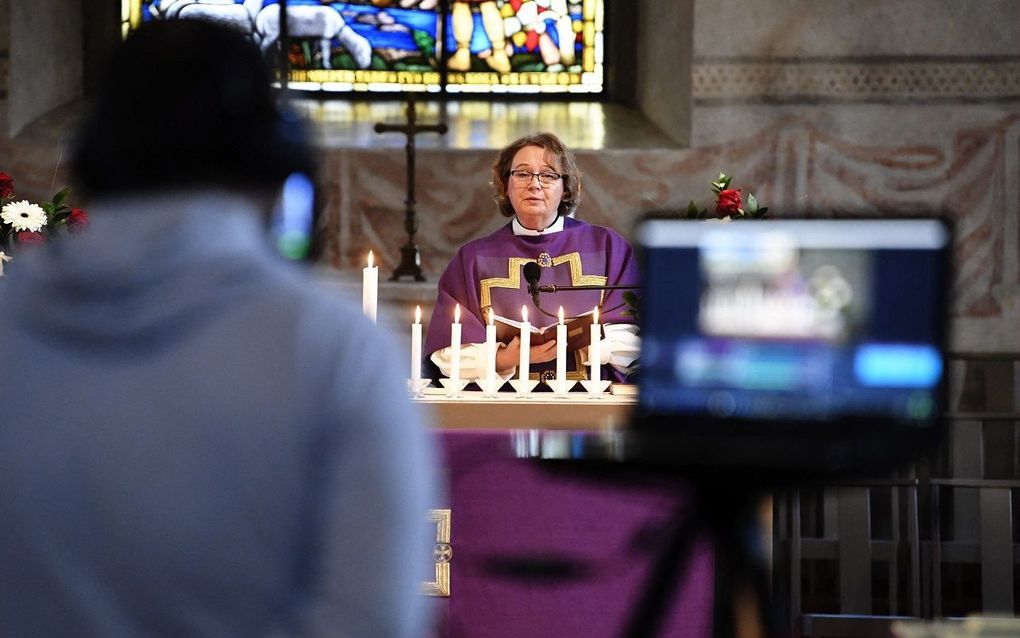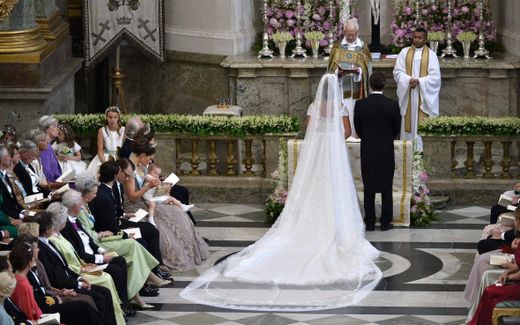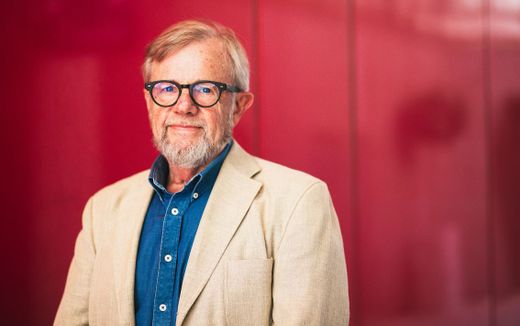People’s church Finland at a crossroads
16-06-2021
Northern Europe
Geerten Moerkerken, RD

Parish pastor Marja Malvaranta serves the Maundy Thursday mass to her parishioners via webcast from the Espoo Cathedral in Espoo, Finland on April 9, 2020. photo AFP, Vesa Moilanen
Northern Europe
The persecution of a Finnish MP and a bishop for their views on same-sex marriage is splitting Finnish society and the people’s church. While the Finns are becoming more and more secular, the Lutheran people’s church struggles with its position.
It is a unique paradox. While Scandinavian countries are at the forefront of liberal themes, national people’s churches still function precisely in these countries: most Scandinavians are church members. Even more than elsewhere in Europe, it asks how to relate to an increasingly progressive society.
Dealing with same-sex marriage is particularly a hot topic. There is a reason for this: because of the position of the Lutheran churches as a people’s church, clergymen have the right to perform marriages before the law. While active church attendance in these countries is generally low, relatively many people marry in church. It poses the question of how to deal with the blessing of marriages between people of the same sex.
In addition, the Finnish people’s church, the Evangelical Lutheran Church of Finland (ELCF), is the odd one out in the Nordic countries. The Lutheran churches of Denmark, Iceland, Norway and Sweden already allow ecclesiastical marriage of the same sex. In Sweden, the church is even obliged to perform these marriages – although an individual priest may refuse to do so. However, the Finnish church does not allow same-sex marriages in the church, even though Finland has officially recognised same-sex marriage since 2017.
Sharp division
That is not to say that the theme is not an issue in the Finnish church – quite the contrary. The subject is a “hot potato” and “divides people,” says Dr Jakob Dahlbacka, associate professor in Church History at Åbo Akademi University in Turku, Finland. “The moral views of the Finnish population have rapidly become more liberal in recent decades, for example, on issues such as sexuality, abortion or divorce. This has also led to an increasingly sharp division within the church.”
Traditionally, the ELCF has had a special position as “folkkyrka”, the folk church of Finland, explains Prof. Jouko Talonen, emeritus professor of Church History at the University of Helsinki. Thus, for example, the church has the right to collect tax, parliament still has a role in ratifying the church order, and priests can therefore marry people before the law. There is one other Orthodox church with such rights, but only 1 per cent of Finns are members thereof, while at least two in three people are members of the Lutheran People’s Church.
Culture Christianity
The church’s position in Finnish society makes Finland one of the most Lutheran countries in the world. However, that is rapidly changing. Only a tiny proportion of Finns have been active churchgoers or personally believe in the church’s teachings, Talonen says. Yet, the influence of the church is still significant in the country. For example, the average Finn attaches great importance to the church’s role in special events, such as baptism, a wedding or a funeral.
In comparison, while only about 3 per cent of Finns regularly attend a church service, at least 93 per cent of the population attended at least one service around such a special occasion last year. In addition, Dahlbacka points to the church’s annual confirmation classes, usually taking the form of camps in the summer, for young people: last year, they were attended by at least 70 per cent of all 15-year-olds. The church, therefore, has an essential function in the form of cultural Christianity and thus leaves a mark on Finnish society.
But Finland is not immune to the rapidly spreading secularisation in the western world, Talonen says. “Since 1960, this has become visible throughout society. Nevertheless, even in those years, the church continued to play an important cultural role: around 1980, 90 per cent of the Finns were still members of the ELCF. Since the beginning of the 21st century, however, a large exodus became visible from the popular church. Although the church admitted women as clergy in 1986 to modernise, younger generations have lost interest in the traditional church.” Today, 68 per cent of the population is still affiliated with the Lutheran Church. However, this group is shrinking by about a percentage point per year.
Church abandonment
Dr Hanna Salomäki sees this as well. As director of the ELCF research institute, she is closely involved in annual surveys of Finnish church and society developments. The ongoing church abandonment is particularly rampant among 20 to 40-year-olds, she says.
Salomäki and her fellow researchers view the changes their studies uncover as “a turning point for cultural Christianity in Finland and more broadly in Nordic countries. The traditional connection to the church is breaking down; traditional folk-based religiosity and customs are replaced by the conscious choice not to be associated with the church or its activities. As a result, people no longer see it as necessary to associate their children with that church.”
The latter development is also visible in the baptism figures, says Dahlbacka. “Fewer and fewer children are being baptised; last year, this was just over half of all newborns. Parents are increasingly taking the position that baptism should be the child’s own choice.”
Even within the church, more significant differences are becoming apparent, according to the church historian. “There is a dividing line between conservatives and liberals. While the former emphasises the church’s preaching role, the latter emphasises fighting inequality and championing minority groups.”
Gay marriage
This growing contradiction is accentuated in the same-sex marriage debate, dividing the church to the core for at least two decades. After Finland made registered partnerships possible for gay couples in 2002, a discussion started in the ELCF about the role of the church. Eight years later, there is a solution: the church declares that it is allowed to pray with gay couples but not to use official church rituals.
The compromise doesn’t satisfy anyone really, says Dahlbacka: it causes both supporters and opponents of gay relationships to cancel their church membership. The discussion would only intensify when parliament approved the legalisation of same-sex marriage in 2014, which would eventually come into effect in 2017. Once again, it became apparent how significant the differences are. An official request reached the Synod in 2016 with the proposal to waive the right to marry people as a church. However, in the same year, an appeal was also submitted to allow ecclesiastical confirmation of same-sex marriage.
The church chose neither option. Instead, it wanted to maintain its position as a people’s church with the right to marry and clings at the same time to marriage as a union between man and woman.
In the meantime, the division is no more minor on the ground. Thousands of members left the church in 2014 out of outrage over Lutheran Archbishop Mäkinen’s positive pronouncement on same-sex marriage. At the same time, some priests want to marry gay couples within the church and do so – against church policy. Sanctions follow, leading to lawsuits. In the end, the highest court ruled in favour of the church – she may sanction priests for this – but by then, that ruling is almost no longer necessary. The church has become very reluctant to act, Talonen says. “In practice, a priest can now perform a same-sex marriage without consequences, although from place to place, consistories of bishops handle this differently.”
The most significant opposition to same-sex marriages within the ELCF comes from the so-called revival movements stirring vigorously within the church. There are five, four of which are rooted in the great revivals of German pietism that took place during the 19th century, says Dahlbacka. “By far, the best-known revival movement is the Laestadian one. Their big summer conference can attract up to 100,000 visitors. The revival movements play an important role within the Lutheran church; about one in five Finns say they have been affected. They are also unique in that they have remained within the folk church. Similar revival movements in other Nordic countries have often seceded and started churches themselves.”
Most active churchgoers also come from the revival movements, Talonen says. “In some areas of the country, the Bible Belts, there are even congregations that are still alive as in the old golden times. At the end of 2019, there were still three congregations where more than 90 per cent of the village was a church member. These Bible Belts are mainly located in northern Finland and the western coastal region of the Gulf of Bothnia.”
Turning point
For the time being, the discussion about same-sex marriages will not be settled, the emeritus professor expects. However, researcher Salomäki states that a lot is moving beneath the surface. She refers to a study from 2019, which shows that there is now a majority in both society and church for the right to a church-based same-sex marriage. Moreover, it appears that acceptance has increased by about 10 per cent in just three years, even among the most loyal churchgoers.
According to the researchers, there is a turning point that is more often visible around similar themes. Once a majority is in favour, social pressure within a group becomes a reinforcing factor, accelerating the acceptance process. They argue that this turning point in Finnish society took place in 2017 and will reach the most traditional groups within the church within a few decades.
The recent charges against the MP Päivi Räsänen –who spoke out against same-sex marriage– and the Bishop Juhana Pohjola –who collaborated on a publication to this effect– have in any case also sharpened the case within the Finnish church. While the Bishop of Helsinki condemned Räsänen’s statements, the Bishop of Mikkeli defended her. Archbishop Tapio Luoma said in May that he would not comment on the case as long as it was before the court.
“Malevolent tongues claim that whatever statement Räsänen makes concerning the Bible increases the number of dropouts,” says Dahlbacka. “Church leaders in the past have often been quick to point out that Räsänen does not represent the church’s official line. But, on the other hand, others point out that –although she is a politician– with her statements, she is doing exactly what the church ought to, were they living up to their mission.”
Personally, Dahlbacka does not believe that Räsänen will be convicted. However, he suspects that the legal procedure might turn out protracted and lengthy. “And if she is convicted, I fear that it will turn out to open Pandora’s box, with unknown –and undesired- consequences. Whatever the outcome, the fact that the prosecution decided to make a case for this is likely to make Christians more likely to self-censor what they say on such subjects for fear of persecution. I, therefore, understand that this case is being followed from abroad as this could set a precedent.”
According to Talonen, there is also a lot at stake in the lawsuits. “I think this issue is a real test to see what Finlands role as a state is, as the state guarantees rights to everybody. Both Finland and Brussels have regularly criticised Hungary and Poland when it comes to human rights. So, it is paradoxical that our public prosecutor is now gnawing at fundamental human rights and the principles of a healthy society with this legal process. Räsänen’s statements are not about agitation or aggression towards sexual minority groups, but about traditional Christian teachings and the right to express them out aloud.”
This article was previously published in the Dutch daily Reformatorisch Dagblad on June 12, 2021.
Related Articles





